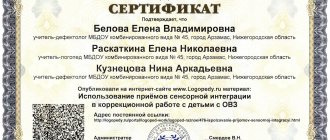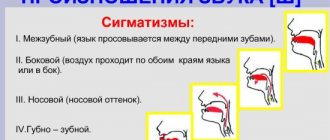You've probably noticed that the French pronounce the letter "r" differently than we do.
And there are people who from birth have a speech defect such as burring the letter r. Parents take them to doctors and speech therapists, trying with all their might and means to rid their child of this speech feature.> But for various reasons, some people strive to master this speech feature. The reasons are always different, the most popular of them is learning French, where gradation is an integral requirement for correct pronunciation. In any case, no matter what your reasons are, the methods of studying are the same for everyone.
Etiology of speech disorder
When pronouncing “R” correctly, the tongue should rise to the palate near the front teeth. This is how vibration appears, which gives this sound. Problems with “R” in adults begin in childhood. The main causes of burr are:
- injuries – defect of the tip or frenulum;
- cervical spine injuries;
- hypoxia during childbirth;
- hydrocephalus;
- intracranial pressure;
- hearing aid disorders;
- inflammatory changes in the hearing aid;
- congenital hearing loss;
- pathologies of phonetic hearing;
- poor bite or missing teeth;
- short bridle;
- paralysis, paresis;
- palate pathologies;
- speech or mental development delays;
- "cleft" lip;
Another reason is the development of a child surrounded by people with impaired hearing and speech. So, from early childhood, the baby hears and gets used to incorrect pronunciation. Burr is not a serious speech therapy disorder; with the help of a course of speech therapy assistance, it is completely corrected.
Thus, four main groups of causes of rotacism can be distinguished:
- Mechanical. Pathologies of the structure of the articulatory apparatus.
- Imitative. The child copies the incorrect pronunciation from the parents.
- Acoustic. Incorrect phonetic perception of the sound “R”.
- Neurological. Pathologies of the speech departments of the human brain.
Before a speech therapist develops a course on how to get rid of burr, it is necessary to accurately determine the cause of its development or appearance.
A little introductory information from an experienced burr
Burry people speak from their throats. I also spoke. This makes for a completely different sound. Just as the throaty R is unusual for you, the tongue-tip R is unusual for the burr. But it is not necessary to burr at all sounds, both hard and soft. I already talked about this above. I had practically no problems with R, as well as with L.
But this does not mean that R was easy. These sounds are pronounced completely differently. Like L and L. Do you think it’s possible to burr with L? It’s easy, try to pronounce it with your throat: press the root of your tongue to your upper jaw and try to say L. Yes, yes...
Types of burr
There are different types of rotacism. Depending on its etiology, there are two types:
- Velar. The vibration occurs at the edge of the soft palate.
- Uvular rotacism. The vibration occurs on the small uvula of the soft palate.
In a broad sense, there are several forms of burr (rhotacism):
- Simple or monomorphic. The pronunciation of one or more sounds of one group is impaired - “S Z C”, “ZH Sh Ch”.
- Polymorphic or complex. The articulation of phonemes from different groups is impaired.
- Physiological. Also called age-related. With it, sound pronunciation is impaired in children under five years of age, which is associated with insufficient development of articulatory organs.
- Functional. Rotacism develops in the absence of problems with the articulatory apparatus, central nervous system, hearing and other devices and systems.
- Mechanical or organic. The development of rhotacism is associated with congenital or acquired pathologies of the speech apparatus.
An accurate diagnosis can only be made by a speech therapist. The definition of burr determines the choice of methods for its correction.
Rotacisms
Correction of burr in adults and children depends on the form of rhotacism. They are as follows:
- There is no “R” in the speech (handle - uchka, river - eka);
- Velar rhotacism or soft pronunciation. The root of the tongue comes into contact with the soft palate, namely its lower edge. A stream of air passes through the gap between them during pronunciation, causing the palate to vibrate.
- Uvular rotacism. Often called "throat".
- Side. The vibration occurs on the side of the tongue, not on the tip. This is how a sound similar to “l” or “rl” appears.
- Bilabial. This type is also called labial, labial or bilabial. Distortion occurs when the lips vibrate, this is how it turns out “prr”. Speech therapists call this sound a coachman's sound.
- Interdental or interdental. Sound pronunciation is caused by the position of the tongue between the teeth.
- Single-strike or proto. Reminds me of “d”, it’s impossible to pronounce the long “RRRRRRRR”.
- Buccal. The exhaled air passes between the cheeks, which causes vibration.
- Nasal. The root is in contact with the soft palate, and air passes through the nose.
- replacing “P” hard with soft.
- Labiodental. The sound is formed between the lip and the upper teeth.
- Laryngeal or laryngeal.
Depending on the form of rotacism, certain exercises are selected aimed at correcting this phenomenon.
Pararotacisms
Pararotacism is the replacement of the rumbling “R” sound with a softer one. The main causes are paresis, short frenulum, impaired phonetic hearing and copying incorrect pronunciation from adults. With pararotacism, the following “P” substitutions occur:
- c: appears in the absence of vibration - “wuka - hand”;
- d: it turns out “hand - duka”;
- g: “hand – guka”;
- n: hand – puka;
- l: hand - bow;
- s: hand – yuka;
- y: hand – yuka.
Correction of pararotacism has many similar sections to burr. The most basic exercise for this is tongue twisters for burr.
Functional burr
Functional burr can develop in a child due to chronic diseases. Another common reason is pedagogical neglect - when a child is given insufficient time from parents and adults, the child develops slowly, not because he has problems with the intellect, but because no one works with him or they do not do it enough.
Often this phenomenon develops in children from bilingual families, that is, adults speak different languages, or from families where one or both parents have such problems. In this way, the child copies the pronunciation of adults. Also, this type of burr may appear due to the presence of disorders of the articulatory apparatus or underdeveloped phonetic hearing.
Organic burr
Occurs due to the structural features of the oral cavity - teeth, bite, tongue (frenulum). A child or adult may burr due to improper jaw structure or lack of teeth. In this case, it is impossible to get rid of rotacism without the help of dentists and an orthodontist. The organic form can appear during life as a result of trauma.
Sensory tongue-tiedness (dyslalia)
This speech disorder is also called tongue-tied or dyslalia. This consists of the inability to pronounce certain sounds or series of sounds. Tongue-tied sounds can be all vowels or all consonants. In the simplest cases, tongue-tiedness affects one or more. Such phonemes are sometimes dropped out or replaced by others. Tongue-tiedness can be called the most common speech defect in a child.
Functional tongue-tiedness is a consequence of improper speech development. It usually occurs at 3-4 years of age and can continue into preschool age. Cases of tongue-tiedness in adults are rare, but they do exist.
How to distort the letter "r"
On specialized resources Rotacism the following main variants of distortion of the sound “r”, or scientifically called rotacism, are described:
- Burr, or throaty “r”. It is not the tip of the tongue that vibrates, but the soft palate. This pronunciation is normal for French and German, but not for Russian speech.
- Lateral "r". One side of the tongue is pressed against the upper teeth, the other side hangs down, and the tip does not vibrate. The result is something similar to “rl”.
- Single-stroke "r". Instead of vibrating, the tip of the tongue hits the hard palate once, forming something like the English r.
- Nasal "r". When you exhale, the air flow does not pass through the mouth, but through the nose. In addition, the tip of the tongue is pulled back and does not participate in articulation. The phrase “Roma, open the doors!” will turn into “Ngoma, otkngoy dvengi!”
- Kuchersky "r". And again, the vibration occurs in the wrong place, namely on the lips close together. The baby makes something similar to “whoa.”
- Pararotacism, or replacement of “r” with another sound. Instead of “child” you hear “child”, “hebyonok”, “vebyonok”, “yaebyonok” or even “yebyonok”.
- Missing "r". The kid simply avoids difficulties. He says not “fish”, but “yba”, not “glad”, but “hell”, not “thunder”, but “gom”.
Causes of speech impairment
Burr can be caused by a variety of reasons. This can lead to:
- physical or neurological weakness (occurs with chronic diseases);
- parents do not correct the child’s speech when there are mistakes in it or the child pronounces some sounds incorrectly;
- the child hears incorrect speech from adults and copies it;
- phonetic hearing and sound recognition are not sufficiently developed;
- incorrect articulation;
- pathology of the articulatory apparatus.
Burrs can occur after injuries. This is the main reason for the appearance of such a defect in adults. In some cases, correction of burr in adults cannot be carried out without the help of other specialists.
Consonants at the end of words
The rule also applies to all those consonants that you will study further: at the end of words they do not undergo any changes and sound as clearly as before a vowel sound.
Watch yourself: read Russian words out loud
ra
b
, rad
,
ro
v
.
What do you hear at the end of words?
You hear: [ra
p
], [ra
t
], [rof
]
.
Never make such substitutions in your French speech!
Exercise No. 4.
Pronounce, clearly contrasting the final sounds:
, [rar - pab], , , .
If a word ends with the sound [v], then any stressed vowel before it, as a rule, is lengthened, for example. The colon in transcription indicates the length of the vowel.
Exercise No. 5.
Say, distinguishing between final
[f]
and
[v]:
, , .
Symptoms of speech impediment
Typical symptoms of burr or rotacism are:
- incorrect pronunciation of hissing and/or whistling sounds – sigmatism;
- difficulty in pronouncing whistling and hissing sounds - parasigmatism;
- pathologies with sonorants [р], [р`], [л], [л`];
- problems with back-lingual phonemes - [g], [g`], [k], [k`], [x], [x`] - gammacism, cappacism and hitism;
- pathology [th] (yotacism);
- replacing voiced consonants with voiceless ones or mixing such phonemes;
- violation of the softness of sounds.
All these manifestations are typical symptoms of burr.
Sounds [a], [p], , [t], [d], [f], [v], [m], [n]
| French sound | Similar Russian sound | French letters and letter combinations | Notes |
| vowel | [a] as in the words take , dan , i.e., like [a] under stress before soft consonants | A, a À, à | The ` icon serves to distinguish certain words in writing, for example: a - has ( verb form ); à is a preposition that conveys the meaning of the Russian dative case (to whom? to what?) and other meanings . The capital letter À is more often represented as A. |
| consonant | [p] as in the word par | P, p | Do not confuse the uppercase and lowercase French letters P, p with the Russian Р, р ! |
| consonant | [b] as in the word b ar | B, b | Do not confuse the capital French letter B with the Russian V ! |
| consonant [t] | [t] as in the word taz | T, t Th, th | |
| consonant [d] | [d] as in the word dar | D, d | |
| consonant [f] | [f] as in the word f act | F, f Ph, ph | |
| consonant [v] | [in] as in the word in al | V, v W, w | The letter W, w is rarely used and is read as [v] in some borrowings from other languages, for example in the word w arrant - guarantee. |
| consonant [m] | [m] as in the word mak | M,m | |
| consonant [n] | [n] as in the word our | N, n |
Please update/change your browser if you experience problems with the audio player below.
Exercise No. 1.
Clearly and energetically say:
[ra - ba - ta - da - fa - va - ma - na].
Exercise No. 2.
Opposite the letter or letter combination, write the transcription. Test yourself using the table above.
| Sample: |
| T[] | f [] | t[] | F[] |
| d[] | p[] | à [] | a [] |
| A[] | B[] | b[] | ph[] |
| D[] | Ph[] | n [] | V[] |
| M[] | N [] | Th[] | P[] |
| m[] | v[] | th[] |
Exercise No. 3.
Read the sounds from the transcription, not forgetting about their clear and full-voiced pronunciation.
Test yourself using the table above. [n], , [m], [d], , [f], [p], [v], [t].
Speech therapy diagnostics
Before prescribing exercises for burr, it is necessary to conduct a detailed speech therapy diagnosis. It begins with a conversation between the child and the specialist. To develop corrective work for rotacism, the speech therapist must determine the following parameters:
- peculiarity of pronunciation of phonemes;
- features of the baby’s psycho-speech development;
- identify defects in sound pronunciation through phonetic analysis;
- assess the condition of the articulation apparatus and identify its defects and pathologies;
- assess the child's vocabulary;
- identify features of writing, grammar, memory, reading;
- determine the level of visual perception;
After these steps are completed, a phonetic hearing assessment is carried out, and then a plan is made to eliminate the burr. In some cases, you will need the help of other specialists - a psychotherapist, a neurologist, a dentist, an otolaryngologist and others.
Is it possible to learn to burr?
Anyone can learn to burr or pronounce the letter “r” in the French or German manner. The main thing is to study and do the exercises.
If you can’t learn to burr at home, you can contact a speech therapist. He will tell you why it doesn’t work and what mistake needs to be corrected.
In extremely rare cases, the problem may be in the structure of the jaw apparatus and the length of the frenulum. A frenulum that is too short may interfere with the correct pronunciation of sounds. A simple dental surgery can correct this physiological problem.
Physiological characteristics do not allow the “r” to burr.
The frenulum is cut under local anesthesia, which takes a couple of minutes. After this, you may experience discomfort for a couple of hours, and then everything will return to normal.
Exercises with a corrected frenulum will be more productive, because nothing else will interfere with you.
Correction methods
There are several methods for correcting burr in adults and children. As the main techniques, the speech therapist uses:
- logomassage;
- exercises to vibrate the front of the tongue;
- tongue twisters starting with the letter “P” from burr;
- classes for automation “R”;
- speech therapy exercises;
- articulation gymnastics;
- speech control.
For the child, the exercises take the form of a game. The main requirement for correcting rotacism is the regularity of these classes.
In children
For children, speech therapists use the following exercises:
- «We brush our teeth." It is necessary to open your mouth wide, smile, make movements reminiscent of brushing your teeth with a brush - movements left and right.
- “We stroke the sky, that is, the palate.” With your mouth open, stroke the palate with your tongue. It should return to the base of the upper jaw.
- "Air battle". Open your mouth, put your tongue on your lower lip and in this state try to pronounce “F”. The escaping air stream should be narrow. This exercise should create a continuous, long stream of air in the middle of the tongue.
- "Sweet tooth." Open your mouth and fix your lower jaw so that it does not move. Lick your upper lip with your wide tongue. It should move from top to bottom. The jaw should not lift it.
- "Turkey". Place your tongue on your lower lip; it should be wide. It is necessary to lick the lower lip back and forth adding voice. A characteristic chattering sound should appear.
- "Drum". Hit the alveoli with your tongue while pronouncing “D”. The mouth should be open.
In teenagers
When working to correct burr in adolescents, basic speech therapy exercises are used. Additional speech therapy exercises are also used:
- A probe (a metal stick similar to a pencil) is placed on the front of the tongue; the tongue must be bent and straightened alternately. The probe must be held in a perpendicular position.
- When performing the “cup” exercise, a pea is placed on the tongue. In this case, the tongue should bend its edges, and the pea should be held on it.
- With your tongue still, turn over the cubes of bread, peas or beans.
- Blow a small piece of paper off your tongue.
- Create a stream of air to vibrate the tip of your tongue. At the same time, a pencil rolls over its surface.
- Massage to strengthen muscles.
You can also get a rolling “R” with the help of exercises for children, pronouncing tongue twisters, of which there are a large number.
In adults
There are some exercises on how to get rid of burr as an adult.
The main cause of burr is incorrect articulation or features of the articulatory apparatus. To make the sound “R”, an adult must perform certain activities at least 2-3 times a day for several weeks. Each lesson lasts approximately 10 minutes. There are exercises aimed at different parts of the articulatory apparatus.
Exercises for the hyoid ligament:
- use the tip of your tongue to reach your nose;
- press the tip to the palate in the area of the roots of the teeth and move it as far back as possible;
- open your mouth, stick out your tongue as much as possible and bend it as high as possible;
- run your tongue along the back of your teeth;
- Fold your tongue into a shovel shape and stick it out as far as possible.
Such exercises are aimed at increasing the elasticity of the hyoid ligament, which is often the cause of this speech disorder.
There are other exercises for the tip of the tongue:
- lightly bite the tip of the tongue;
- press it tightly to the sky, click it;
- stick out your tongue, press it to your lip and in this position exhale air so that vibration appears;
- open your mouth, try to pronounce “D” and “T”.
After mastering the sound, you need to start consolidating, that is, automation:
- The sound “R” is pronounced at first like “T” and “D”, but with the necessary vibration. The tongue should be pressed to the palate, directing a stream of air;
- When vibration is received, you can pronounce “TRRRRR”, “DRRRRR”;
- Connect vowel sounds - “tro”, “dro” and others similar;
- Try to pronounce words with “R”;
- Automate tongue twister skills with this sound.
It is better to increase the effectiveness of these exercises in the mirror. The more often an adult does such activities and the more regularly, the faster this speech disorder will be corrected.
At first, the sound will be more like the growl of a poorly functioning engine. The more and more often you do the exercises, the sooner the letter “P” in speech will become similar to how announcers pronounce it. You can test yourself by recording tongue twisters on a voice recorder (they are now available in almost every mobile phone). If you save these files, you can later track changes in pronunciation.
French pronunciation
Features of French pronunciation:
- When articulating, the lips should not close tightly. The sound becomes fricative.
- When the speech apparatus operates, special vortex movements of a small air flow are created, with the help of which the sound “r” is pronounced.
- In French pronunciation, friction noise and specific vibrations do not arise: the sound is slit.
Correct articulation involves changing the position of the soft palate, while the back surface of the tongue should remain inactive. There should be a small tongue in a tense state during pronunciation, but it does not vibrate.
The sound “r” in French is classified as a sonorant, voiced, deep-back or uvular consonant. Unlike the sound familiar to Russian people, it is pronounced with the small tongue, and the large tongue is not used at all.








